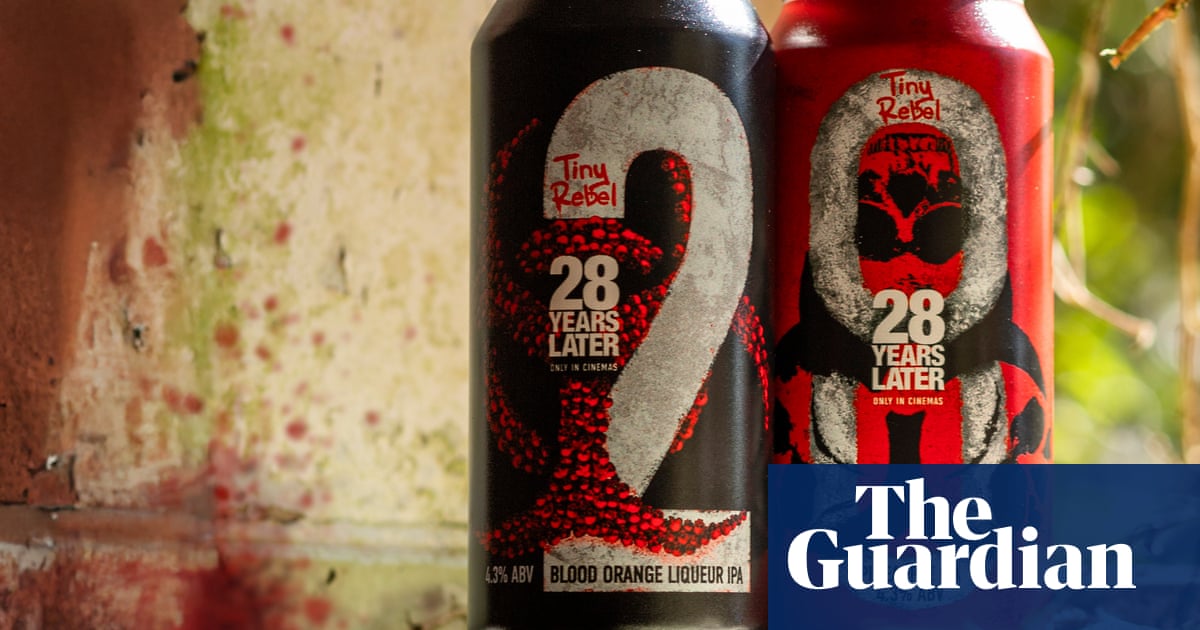With ticket sales no longer a sure thing, additional income streams have become more important than ever to the movie business. If you want to know how much faith a studio has in a property, your best bet is to look out for licensed merchandise. This is why Wicked partnered with 400 corporate brands ahead of its release last year and why every shop on the high street is heaving with Lilo & Stitch merch. It’s why the last bag of Doritos you ate had Jack Black’s face on it.
But this strategy isn’t failsafe. Yes, if you’re promoting a big four-quadrant blockbuster, it’s easy to team up with companies who’ll paste their products with adverts for your film. However, if your film is too small, or too sad, or too weird, then any sort of brand collaboration is going to seem an extremely odd fit. In other words, can I interest anyone in a pint of 28 Years Later beer?
No, really. This week a press release announced that “independent craft beer mavericks” Tiny Rebel are “dialling up the chaos” by launching two new official 28 Years Later IPAs. One of them is a “blood orange liqueur-infused IPA with an infectiously juicy bite”, the other is a “tropical pineapple IPA that’s as bold as it is refreshing”, and both are “inspired by the ferocious energy and apocalyptic vibes of the new 28 Years Later film, bringing fans a taste experience as intense as the film itself”.
Which isn’t to say that the beers sound bad. Maybe they’re a bit try-hard, sure, and aimed slightly too aggressively at 40-year-old men who wear little tiny beanie hats, but each to their own. Nevertheless, I cannot legitimately think of a situation where I’d walk into a pub and deliberately seek out a beer with palpably apocalyptic vibes. There is no feasible way that – were I to point at a beer and ask the server “Is this intense?” and they reply “Yes, it is exactly as intense as that film where an emaciated zombie gets machine-gunned to death by a screaming soldier as it kills and eats his friend” – I would say “Ooh, that sounds nice. One of those please.”
Again, this isn’t a knock against 28 Years Later. Based on everything we’ve seen so far it looks like exactly the sort of poundingly intense folk horror that we don’t make any more. It looks like a film (and this is a compliment) where you don’t want to walk home alone in the dark after the credits roll. I am extremely excited to see it.
The problem is trying to marry this sense of oppressive dread to happy funtimes. And this has always been an issue with this particular series. Nine years ago, I was asked to go and watch 28 Days Later at a screening hosted by the immersive Secret Cinema group. And I hadsucha crap time. Had I been sent to go and see (for example) Grease, it would have been a different matter entirely. If I’d seen Grease, I’d have been surrounded by cool cars and gum-popping girls and spontaneous dance parties.
But no.I went to see 28 Days Later, which meant that it was full of extras in military uniforms angrily yelling at everyone, and a siren that went off every five minutes requiring all the ticketholders to crouch down for an arbitrary amount of time for no specific reason, and really overpriced cheeseburgers. All of which is perfectly in keeping with the tone of the film, but as a mode of entertainment in itself it was excruciatingly bad.
That’s the problem, really. 28 Days Later is a masterpiece – and the same might be said for the new sequel – but it isn’t one you necessarily want to live inside. You’re meant to survive it, not sip it. The fact that there’s a branded tie-in beer is probably just a reflection of the world we live in, but you could argue that the fact it exists in the first place only detracts from the film as a piece of art. So thanks but no thanks. If I wanted a pint that feels like the end of the world, there’s a Wetherspoons just down the road.
